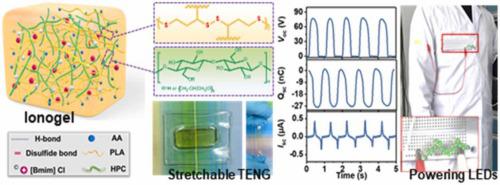Nano Energy ( IF 17.6 ) Pub Date : 2021-10-16 , DOI: 10.1016/j.nanoen.2021.106619 Chao Dang 1 , Changyou Shao 2 , Hongchen Liu 1 , Yian Chen 1 , Haisong Qi 1

|
Ionogels are promising electrode materials of stretchable triboelectric nanogenerators (TENG). However, the development of ionogel materials that simultaneously meet the requirements of green start feedstock, simple fabrication, multifunction, and recyclable feature remains a challenging issue. Here, we try to address this by adopting novel melt-polymerization of hydroxypropyl cellulose (HPC) in molten α-lipoic acid (LA) liquid. This strategy is extremely simple, facile, based on biomass molecules, and offers a promising methodology to completely melt processing of cellulose materials. The HPC chains successfully forms the double-network structure with LA poly(disulfides) chains by multiple hydrogen bonding interactions. As result, the integrated merits of high transparency, high strength, fine stretchability, moderate conductivity, healability, ultraviolet resistance, thermal stability, strain-sensitivity, and full recyclability are realized in the obtained ionogels. Encouraging by these features, a versatile triboelectric nanogenerator (I-TENG) (3 cm × 3 cm) is fabricated using ionogels as functional electrodes. This nanogenerator can harvest biomechanical energies and convert them into electrical outputs of 80 V, 2 µA, 27 nC, and the max power density of 67.9 mW m−2 at a fixed frequency of 3 Hz, respectively. Beside transparent characteristic, this nanogenerator is able to maintain good energy harvesting performance after stretching, high temperature storage, long-term operation, mechanical damage, and even recycling. Notably, the I-TENG can not only work as green power supply to drive small electronics, but also as self-powered sensors to distinguish human motions and English letters.
中文翻译:

小生物质分子辅助纤维素熔融加工制备可回收离子凝胶,用于多功能可拉伸摩擦纳米发电机
离子凝胶是可拉伸摩擦纳米发电机(TENG)的有前途的电极材料。然而,同时满足绿色起始原料、简单制造、多功能和可回收特性要求的离子凝胶材料的开发仍然是一个具有挑战性的问题。在这里,我们尝试通过在熔融 α-硫辛酸 (LA) 液体中采用羟丙基纤维素 (HPC) 的新型熔融聚合来解决这个问题。这种策略基于生物质分子非常简单、容易,并且为纤维素材料的完全熔融加工提供了一种有前途的方法。HPC 链通过多个氢键相互作用成功地与 LA 聚(二硫化物)链形成双网络结构。因此,具有高透明度、高强度、良好的拉伸性、适中的导电性、可愈合性等综合优点,获得的离子凝胶实现了抗紫外线、热稳定性、应变敏感性和完全可回收性。受这些特征的鼓舞,使用离子凝胶作为功能电极制造了多功能摩擦纳米发电机(I-TENG)(3 cm × 3 cm)。该纳米发电机可以收集生物力学能量并将其转换为 80 V、2 µA、27 nC 的电输出,最大功率密度为 67.9 mW m−2分别以 3 Hz 的固定频率。除了透明的特性外,该纳米发电机在拉伸、高温储存、长期运行、机械损坏甚至回收后都能保持良好的能量收集性能。值得注意的是,I-TENG不仅可以作为驱动小型电子设备的绿色电源,还可以作为自供电传感器来区分人体动作和英文字母。

























 京公网安备 11010802027423号
京公网安备 11010802027423号